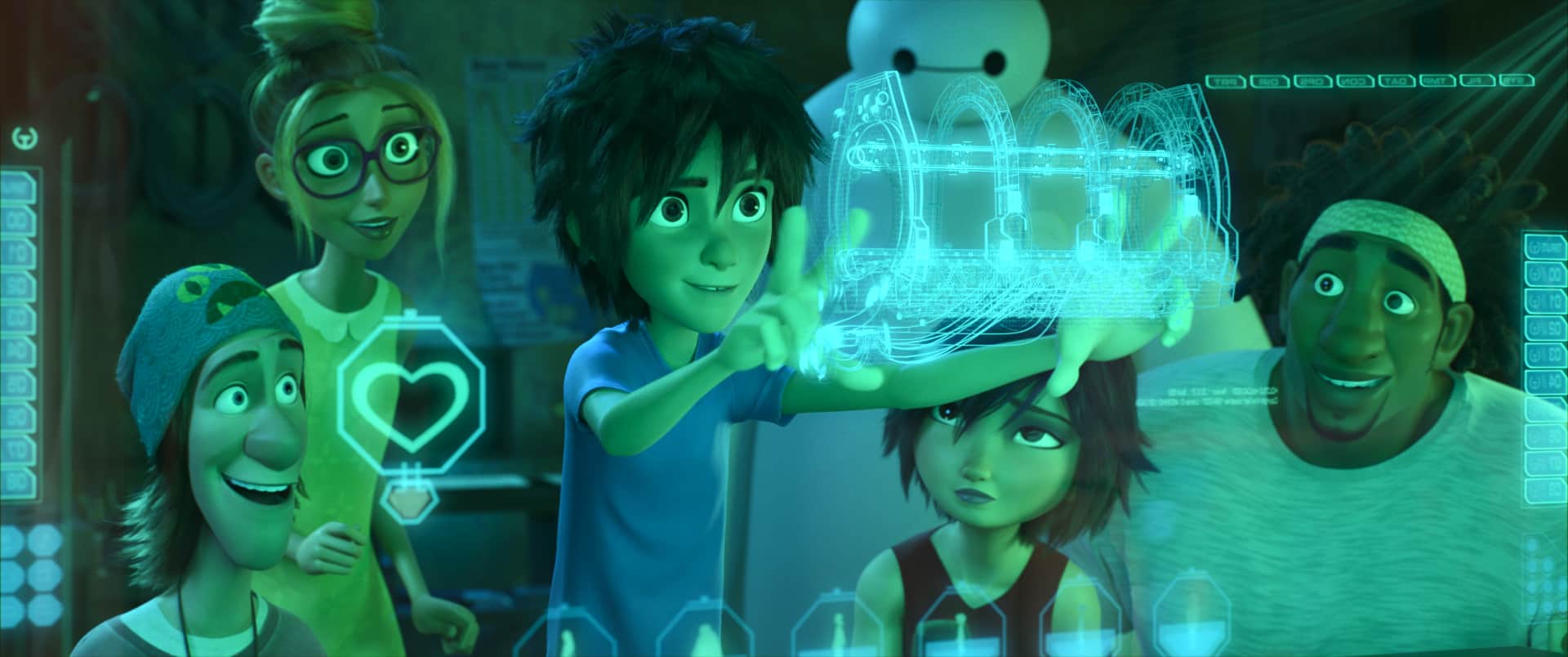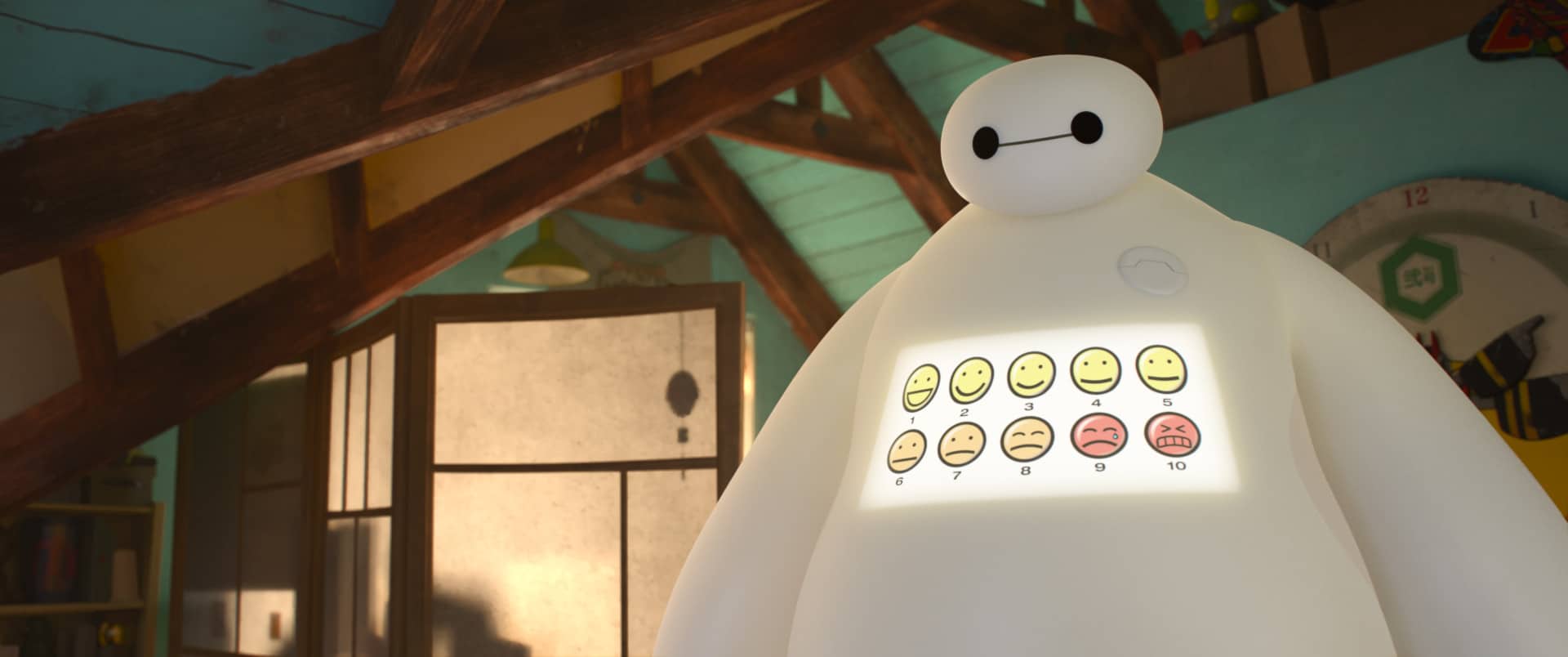The origins of Big Hero 6 come from the Marvel comic of the same name. First appearing alongside the Canadian superhero team Alpha Flight in the Marvel series, they eventually flourished into their own comic adding X-Men familiars “Silver Samurai” and “Sunfire” (neither of whom appear in Big Hero 6 as their movie rights belong to 20th Century Fox), all while staying relatively obscure. The comic’s obscurity is what helped motivate Don Hall into adapting it into a full Walt Disney Animation Studios feature. Screenwriter Robert Baird confessed that he hadn’t even read the comic, and story head Paul Briggs had read only a few issues himself.
The film is set in the fictional combination of San Francisco and Tokyo; the result being the very subtle title of “San Fransokyo.” Instead of simply brazenly inserting already-iconic architecture from both locations (save perhaps, the Golden Gate Bridge), the inspired city is crammed full of unique culturally amalgamated features from both societies. There are the straightforward San Franciscan Victorian houses nestled under Tokyo-esque signage and public transport, as well as a sky littered with adorable futuristic fish-like blimps that serve to generate power for the city. The functionality of Tokyo architecture and the aesthetic of the San Francisco bay commingle well as a scenic visual and as a setting for a film centered around science, discovery, and creation.
Three software programs/engines were used to generate the lush overworld of Big Hero 6. The rendering system titled “Hyperion,” which began development in 2011, required new supercomputers to handle the processing required for the film. Over 2,300 Linux workstations were established for Hyperion. As a result, the setting of San Fransokyo features over 83,000 buildings and 100,000 vehicles (as well as 250,000 trees provided by the software program “Bonzai”), and conveys an observably meshed East/West society – which is something that those familiar with current-day San Francisco have already come to experience.
While still being “Americanized” for Disney’s western demographic, Big Hero 6 does a fair job at splitting the cast and set diversity up the middle. There are over 700 various characters (generated by the software program “Denizen”) that populate the city, including the main cast which is beautifully diverse both culturally and ethnically. The audience is also treated to the uniquely puffy, marshmallow-looking robot known as Baymax. The non-threatening medical bot is without a doubt what carries the film. The innocence, vulnerability, and protective instincts of Baymax are reminiscent of the 1999 film The Iron Giant. Playful dialogue and flawless comedic timing from Baymax keep an audience of all ages in a constant laugh.

Main character Hiro Hamada is a half-white, half-Japanese cocky know-it-all type 14-year old, and is the type of boy with a freshly teenage attitude that viewers have all experienced at some point in their lives. He’s a brat, but he’s a smart brat. Inspired by his older brother (and the creator of Baymax), Tadashi, Hiro is set along a life path that is academic, healthy, and challenging. When an unexpected tragedy snaps Hiro’s world in half, he begins to face crippling depression and must deal with a complete lack of motivation.
The largely built, obsessive-compulsive Wasabi (voiced by Damon Wayans Jr.) breaks a typically expected function of a Black male in the group adhering to an aggressive, intimidating role. Wasabi still asserts his values and strength when contributing to the group in meaningful ways, and especially challenges the main character when Hiro starts to dip into a moral grey area. He becomes a voice of reason, and contradicts his bulky size with being one of the first to flee from conflict.
A sporty, by-definition “spunky”, GoGo Tomago (voiced by Jamie Chung) embraces the brawny role, and with phrases like “Woman up!”, she forcefully proves that being physically strengthened and maintaining “feminine” qualities are never mutually exclusive. As a Japanese-American woman, GoGo also fills in a supporting role without the connotation of her capabilities being limited as a result. She emphatically guides Hiro throughout the events of the film, with no fear of taking control of the situation when she knows she can do a better job at resolving the problem at hand.
The bubbly, high-energy, and stylish Honey Lemon (voiced by Génesis Rodríguez) fully, and with no shame, endorses what would be considered a “girly” persona. She isn’t mocked for her colorful and quirky attitude, and rightfully does not apologize for it. She symbolizes a lively, ambitious scientist in the chemical engineering field; a place where women are still extremely unrepresented. She is also considered ambiguously Latina through her colorful personality and mannerisms, with the slight accent of Genesis Rodriguez coming through when enunciating certain exclamations, keeping both a caring and venturous attitude throughout the events of the film.
The final member of the group, Fredzilla (voiced by T.J Miller) is your standard comic-book loving nerd ambassador of the group. He consumes himself with his hobbies while neglecting his hygiene, and generally serves in a dopey airhead trope with a bit of an obnoxiously convenient amount of resources that allows the crew to carry out their escapades. Think of Shaggy from Scooby-Doo, but with more to contribute and an enrollment into a science institute.

Big Hero 6 by no means tells a terribly unique story, but where it lacks a unique approach to its content it excels in charm. Though the film handles these the adult themes of death, loss, rage, and revenge in a responsible way, the ingredients of the plot, and its devices, are stereotypical Disney. A young character struck with calamity and disaster must learn to adapt and overcome a great threat, and their own personal misfortune, with the help of those around them.
Audiences are not going to see complex issues, social commentary, or boundaries pushed by this film; in part because the film didn’t need to. Also, it’s very much so constructed for a child demographic. That’s not to say movies should ever shy away from presenting a young audience with intricate themes, but it’s the execution of storytelling, detailed environments, brilliant comedic timing, and accessible content that make Big Hero 6 work.
Last Updated on November 28, 2018.









